
Incorporating Wooden Restaurant Furniture
The combination of aesthetics and utility is vital in the field of interior design, particularly in places like restaurants where the atmosphere greatly affects the whole dining experience. Wooden furniture is one of the most popular design elements because of its classic appeal, adaptability, and capacity to add warmth and character to interior spaces. This article delves into the skill of combining wooden furniture with restaurant décor, examining its rustic appeal and the way it may change the atmosphere and patron experience.
A TIMELESS ELEGANCE
For generations, wood has been a common material used to make furniture because of its inherent beauty, toughness, and versatility. Its cozy, organic textures and warm tones lend a comfortable feeling to any area, but it works especially well in restaurant settings where a pleasant ambiance is desired.
The adaptability of wooden restaurant furniture is one of its distinguishing qualities. Wood may be fashioned into a variety of styles to fit a wide range of aesthetic tastes, from sleek, contemporary designs to rustic, farmhouse-inspired items. Because of its versatility, restaurant designers and owners may create environments that accentuate the desired mood, be it a hip urban eatery with an industrial edge or a cozy restaurant tucked away in a charming corner.
EMBRACING RUSTIC CHARM
When it comes to restaurant design, rustic charm has a unique appeal since it evokes feelings of authenticity and nostalgia that appeal to customers looking to get away from the busyness of everyday life. Adding wooden furniture to the design scheme is a good approach to evoke this classic look and create a room that exudes warmth, subtle elegance, and simplicity.
The emphasis on natural materials and textures is one of the defining characteristics of rustic décor. Reclaimed wood tells a tale of simpler times and bygone ages with its worn patina and imperfections. It is the epitome of rustic appeal. Restaurant interiors can be given a feeling of history and character by including pieces made of distressed or reclaimed wood, which also adds depth and visual appeal to the area.
CREATING AN INVITING ATMOSPHERE
The atmosphere of a restaurant greatly influences every aspect of the dining experience, from patron happiness to return business. The environment is transformed by wooden furniture, which contributes to the warm, inviting milieu that entices customers to stay and enjoy the occasion.
Wood’s cozy, earthy tones soothe the senses and inspire sentiments of coziness and relaxation. A booth made of recycled wood or a rustic farmhouse table surrounded by mismatched chairs is two examples of how wooden furniture enables guests to relax and enjoy their meal in a setting that seems like home.
Additionally, the tactile quality of wood engages diners on a visceral level by adding a sensory component to the dining experience. Feeling the grain under one’s fingertips or running a hand over a hardwood tabletop improves the sense of connection between diners and their environment and helps them appreciate the fine craftsmanship and attention to detail that goes into the space’s design.
CONCLUSION
There are several advantages to using wooden furniture in restaurant decor, including its potential to improve the whole eating experience and create a welcoming atmosphere in addition to its timeless elegance and rustic charm. Wood can change places by adding warmth, character, and an air of authenticity, whether it’s in a stylish urban cafe or a little neighborhood café.
Owners of eateries and designers may create memorable dining spaces that have made an impression on customers for a long time by embracing the charm of wooden furniture and carefully selecting a design scheme that strikes a balance between beauty and utility. Wood continues to be a fundamental element of restaurant décor due to its ageless beauty and enduring appeal. It gives every space it is placed in depth, character, and texture.



